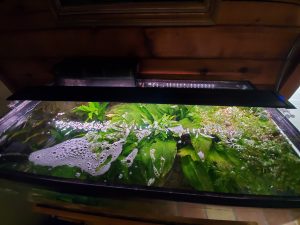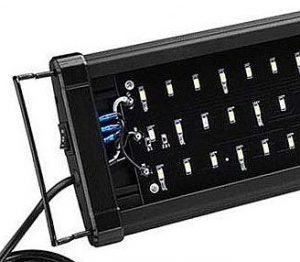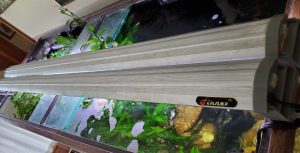LED Lighting has many advantages over other types of lighting for freshwater, brackish, and marine aquarium applications.
First of all, LED stands for Light Emitting Diode.
A diode is an electrical component that has two terminals that conduct energy in only one direction.
When an electrical current is applied to a diode, it excites the electrons in the diode making them release photons which we recognize as a bright light.
The colors that LEDs produce is a direct result of the energy gap in the semiconductor of the diode. This means that LEDs produce a bright spectrum of colors easily, and use very little electricity in doing so.
As of this writing, LED lighting is now the most energy efficient lighting available to tropical fish keeping enthusiasts.
They use 75% less energy than incandescent bulbs and last 25 times longer. Compared to CFL (Compact Fluorescent Lighting) bulbs, they last at least twice as long.
LED bulbs and are more efficient than both CFL and incandescent bulbs because they emit light in a targeted direction, instead of scattering the light around like CFL and incandescent bulbs.
LED bulbs are cooler than other bulbs. CFL and incandescent bulbs release 80 to 90% of their energy as heat.
Most tropical fish keeping enthusiasts, especially those keeping several tanks, have found that the dramatic energy savings, amazing color and shimmer effects, and long lamp life provided by LED lighting is well worth the higher initial cost of the lamps.
LEDs are available in a multitude of color spectrums and combinations for use in freshwater and saltwater. They are dimmable and can be adjusted for brightness and color blending.
When using multiple color spectrums for growing plants or keeping corals, individual colors can be dimmed or brightened as desired.
If you are looking for magic lighting that will really bring out the colors in your marine corals; purchase an LED unit with a light output in the actinic royal blue range.
The actinic will magically make the colors in your corals really stand out. If you keep soft polyp corals and zoanthids, blend in a little magenta to pump up the purples, greens, and orange colors.
Because LEDs are dimmable, programming units with timers are furnished by most manufacturers to simulate daylight and night time reef conditions. Programmable units are also used for freshwater applications to simulate a variety of unique lighting conditions found in South American rain forests.
Although LEDs do not transfer heat directly into the aquarium, they do generate a fair amount of heat upward, and should be provided adequate air circulation so the LED chip is not prematurely degraded. Proper ventilation around the heat sink is always necessary and recommended.
LED lights provide an intense point source light which creates amazing shimmer and glimmer effects in freshwater and marine aquariums. Plain white LEDs produce the most shimmer, and strong surface rippling is not really necessary to create a shimmer in your tank.
With all the good things to say about LED lighting, there are some DON’Ts you also need to be aware of:
- Don’t get LEDs wet.
Even though your LED may be water resistant, or water proof; that does not mean it can be submerged and used underwater. Exposing LED lights to water for any length of time will damage the LED circuit board and no doubt cause your heat sink and/or hardware to corrode.
- Don’t allow salt creep or mineral deposits on the LED strips.
It is important to always keep your LED lights clean and free of salt creep or mineral deposits to prevent premature failure. Mineral deposits in freshwater tanks and salt creep in marine tanks cause corrosion that will quickly damage the heat sink and the LED.
- Don’t keep LEDs close to metal halide
s, compact fluorescents, or T5HO lamps.
Heat is the enemy of LED lights and any electrical component. Never mount them too close to other types of lighting (especially metal halide lights). The heat generated can dramatically decrease the lifespan of an LED.
- Don’t burn your corals.
LED lighting can be very intense, and sudden changes in light brightness can sometimes cause some corals to expel their zooxanthellae and “burn” or “bleach white.”
It is extremely important to slowly acclimate marine corals to new LED lights. Some manufacturers of LED lighting for marine applications provide a “Coral Acclimation Guide” to walk the aquarist through the acclimation steps.
LED light bulbs keep improving in efficiency and quality.
When they were first introduced, LED lighting was far more expensive than other bulbs on the market, however, their costs have since come down dramatically.
For tropical fish keeping applications, LED lighting systems are sometimes the most expensive on the shelf, but economically, their much longer lifetimes, lower power consumption, color combination possibilities, and dimmable/ programmable qualities can usually justify their higher initial cost.




